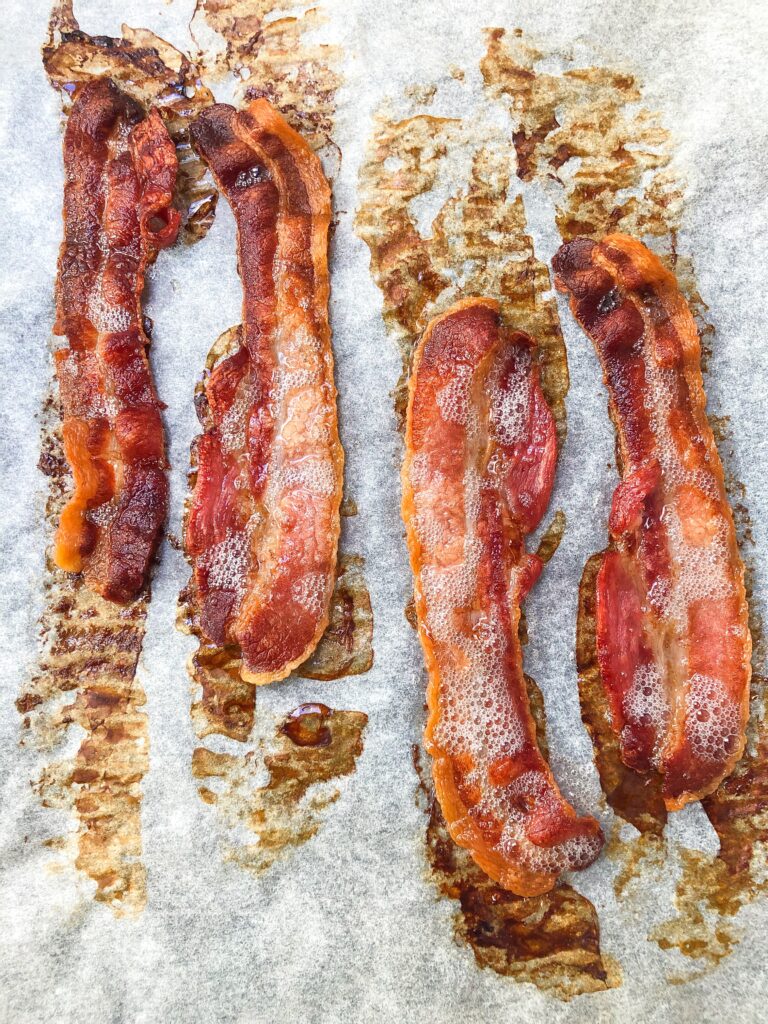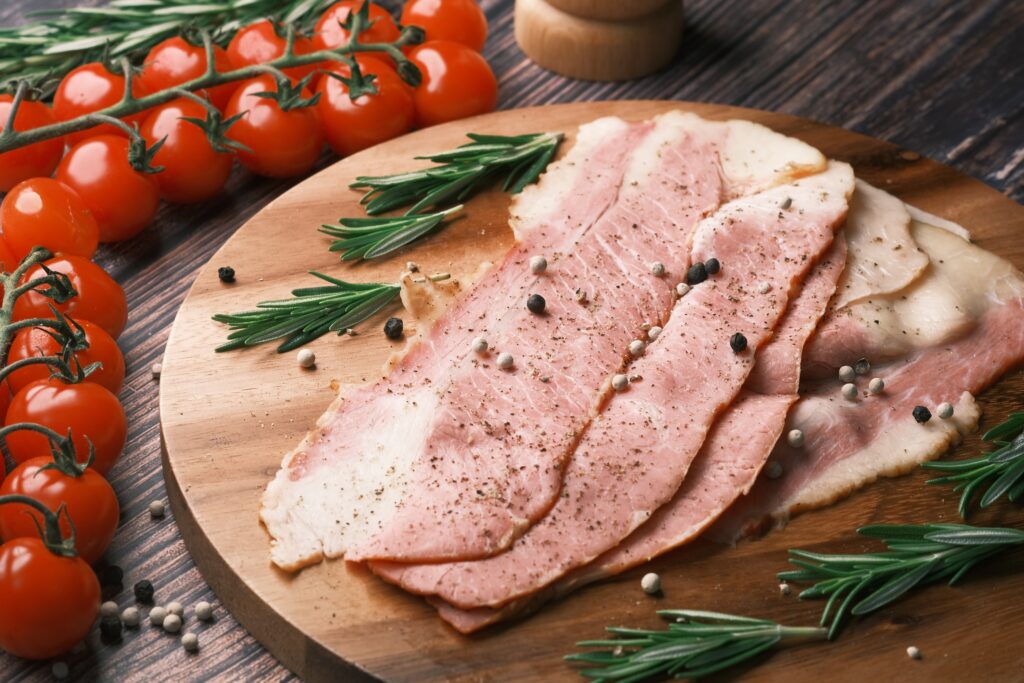In the article “How to Properly Select and Store Bacon,” the author provides valuable information on selecting and storing bacon effectively. With the use of a peek-flap on most bacon packaging, consumers can easily assess the fat-to-meat ratio before making a purchase. The article emphasizes the importance of choosing leaner packages for breakfast side dishes and opting for more fat for other cooking applications. Additionally, the author provides guidelines for storing raw bacon, such as keeping it tightly wrapped and refrigerated for up to a week past the expiration date, or freezing it in individual serving sizes for longer storage. The article also offers advice on storing cooked bacon, including refrigerating it for up to five days or freezing it for later use. With these practical tips, readers can ensure they properly select and store bacon to maintain its quality and flavor.

How to Properly Select Bacon
When choosing bacon, one important factor to consider is the fat-to-meat ratio. Most bacon packages nowadays come with a peek-flap on the back, allowing you to get a good view of the ratio before purchasing it. For those who plan to use bacon as a side dish for breakfast, selecting a leaner package with less fat may be more desirable. On the other hand, if you intend to use bacon for other cooking applications, such as flavoring a dish or adding richness to a sauce, choosing a package with more fat content would be recommended. Ultimately, the choice of bacon should be based on the specific recipe and personal preference.
Choose Leaner Bacon for Breakfast
For breakfast, many people prefer leaner bacon that has less fat. Lean bacon is often more suitable for recipes like eggs and bacon or bacon and toast, where the bacon is intended to be the star of the dish. With leaner bacon, you get a crispy texture with a milder flavor. It is important to note that lean bacon may have less fat content, but it can still impart a delicious taste to your breakfast.

Consider Fat Content for Other Cooking Applications
When using bacon for other cooking applications, such as adding flavor to soups, stews, or vegetables, it is essential to consider the fat content. The fat in bacon can enhance the overall taste and provide richness to the dish. In these types of recipes, choosing bacon with a higher fat content can be beneficial. The rendered fat from the bacon can infuse the other ingredients and create a more flavorful and satisfying dish.
How to Properly Store Raw Bacon
Properly storing raw bacon is crucial for maintaining its quality and freshness. Here are some tips on how to store raw bacon:
Keep Unopened Vacuum-Sealed Bacon in the Refrigerator
Unopened packages of vacuum-sealed bacon can be stored in the refrigerator. This packaging helps prolong the shelf life of the bacon. It is recommended to keep the bacon in the refrigerator, away from other foods, to avoid cross-contamination. Keeping it chilled will also prevent the growth of bacteria.
Wrap Opened Bacon Tightly in Foil or a Zip-Top Bag
Once the bacon package is opened, it is important to wrap the remaining slices tightly to prevent them from drying out. Foil or a zip-top bag can be used to seal the bacon slices. Make sure there is no air trapped inside the wrapping to maintain freshness.
Freeze Sealed Packages of Bacon
If you have excess bacon or want to store it for an extended period, freezing is an option. Sealed packages of bacon can be frozen for up to one month before the fat starts to go rancid. It is recommended to separate the bacon into serving sizes before freezing. Each portion should be tightly wrapped in plastic wrap, then foil, and labeled with the date. These frozen portions of bacon can be kept in the freezer for several weeks.

Tips for Freezing Bacon
Freezing bacon can extend its shelf life and ensure you always have some on hand. Here are some tips for freezing bacon properly:
Separate Bacon into Serving Sizes for Freezing
Before freezing bacon, it is a good idea to separate it into serving sizes. This makes it easier to defrost and use only what you need. You can divide the bacon into 4-piece serving sizes or any other portion that suits your needs.
Wrap Bacon Portions Tightly in Plastic Wrap and Foil
To prevent freezer burn and maintain the quality of the bacon, it is essential to wrap each portion tightly. Start by wrapping the bacon tightly in plastic wrap to seal it. Then, wrap it with a layer of foil for added protection.
Label and Date Frozen Bacon Portions
To keep track of the frozen bacon portions, it is important to label them with the date. This will help you identify the oldest portions and use them first to ensure freshness. Use a permanent marker to write the date on the foil or on a label attached to the package.
Thawing Bacon
Thawing bacon properly is essential to maintain its texture and flavor. Here are some tips for thawing bacon:
Plan in Advance to Thaw Bacon in the Refrigerator
The best way to thaw bacon is to plan ahead and thaw it in the refrigerator. This slow thawing method ensures even thawing and reduces splatters during cooking. Simply transfer the frozen bacon from the freezer to the refrigerator and allow it to thaw overnight.
Refrigerator Thawing Reduces Splatters During Cooking
Thawing bacon in the refrigerator not only preserves its quality but also reduces the risk of splatters during cooking. Cold bacon tends to splatter more when placed in a hot pan, which can be dangerous and messy. Thawing it in the refrigerator allows the bacon to gradually come to room temperature, minimizing splattering.
How to Properly Store Cooked Bacon
If you have leftover cooked bacon or want to prepare it in advance for future use, proper storage is crucial. Here are some tips on how to store cooked bacon:
Refrigerate Cooked Bacon in a Plastic Bag
After cooking bacon, allow it to cool on paper towels to remove excess grease. Once it has cooled, place the cooked bacon in a plastic bag. Make sure to remove any air from the bag and seal it tightly to prevent moisture and odors from entering.
Use Within Five Days
Cooked bacon should be used within five days of refrigeration. It is important to check for any signs of spoilage before consuming it. If the bacon appears discolored, has an off smell, or feels slimy, it should be discarded.
Freeze Cooked Bacon in Individual Portions
To extend the shelf life of cooked bacon, it can be frozen. Before freezing, wrap individual portions of cooked bacon in paper towels to cushion and protect them. Place the wrapped portions in a zip-top bag, remove any excess air, and seal it tightly. Frozen cooked bacon can be stored for up to six weeks.
Cooking Frozen Cooked Bacon
If you have frozen cooked bacon and want to use it, there are several methods for cooking it from frozen. Here are some options:
Cook Frozen Cooked Bacon in a Hot Pan
One way to cook frozen cooked bacon is to place the frozen slices directly in a hot pan. The residual heat from the pan will thaw and heat the bacon. Cook the bacon for about a minute on each side or until it reaches the desired level of crispiness.
Microwave Warming for Frozen Cooked Bacon
Another method for warming frozen cooked bacon is to use a microwave. Place the frozen bacon slices on a microwave-safe plate lined with paper towels. Microwave the bacon in 30-second intervals until it is heated through. The cooking time may vary depending on the wattage of your microwave, so keep an eye on it to prevent overheating.
Discard Darkened and Dry Ends of Slab Bacon
If you have a slab of bacon that has been frozen and notice darkened and dry ends, it is recommended to slice off and discard those portions before using the bacon. The salt in slab bacon tends to make the fat turn rancid quickly when frozen, resulting in dark, dry ends that may affect the overall taste and quality of the dish.
Bacon Equivalents and Substitutions
When it comes to recipes that call for bacon, it is helpful to know the equivalents and possible substitutions. Here are some options:
-
Canadian bacon: Canadian bacon is a leaner alternative to traditional bacon. It is made from the pork loin and has a milder flavor. It can be used as a substitute in recipes that require crispy bacon.
-
Pancetta: Pancetta is an Italian cured pork belly that is often used as a bacon substitute in recipes. It has a rich and slightly salty flavor. Pancetta can be cubed and cooked until crispy or used in its raw form to add depth to dishes like pasta carbonara.
-
Turkey bacon: Turkey bacon is a popular alternative for those looking for a leaner option. It is made from turkey meat and has a similar texture to traditional bacon. However, turkey bacon may have a milder flavor and may require additional seasoning for desired taste.
-
Vegetarian bacon: Vegetarian bacon is made from plant-based ingredients and is suitable for those following a vegetarian or vegan diet. It is typically made from ingredients like soy or tempeh and can provide a similar texture and flavor to traditional bacon.
It is important to note that these substitutes may have different flavor profiles and cooking characteristics compared to traditional bacon. Therefore, it is recommended to adjust the recipe accordingly and experiment with different substitutions to find the best fit.
What Is Bacon?
Bacon is a popular and versatile meat product made from pork belly. It is typically cured, smoked, and sliced into strips before being cooked. Bacon is known for its rich, savory flavor and crispy texture when cooked to perfection. It is a staple ingredient in many dishes and can be used as a main component or as a flavor enhancer.
Bacon is commonly enjoyed for breakfast alongside eggs, in sandwiches and burgers, or as a topping for salads and soups. It can add a delicious smoky and salty taste to a variety of recipes. The fat content in bacon also adds depth and richness to dishes, making it a favorite ingredient for many chefs and home cooks.
How to Store Cooked Food
Properly storing cooked food is essential to maintain its freshness and safety. Here are some general guidelines for storing cooked food:
-
Allow the cooked food to cool completely before storing. Placing hot food in the refrigerator or freezer can increase the temperature inside and affect the other contents.
-
Use airtight containers or resealable bags to store cooked food. This helps prevent moisture loss and keeps out any odors from other foods in the refrigerator or freezer.
-
Label the containers or bags with the contents and the date of preparation. This will help you keep track of the freshness and identify the oldest items for consumption.
-
Store cooked food in the refrigerator for up to five days. After that, it is recommended to discard any leftovers that have not been consumed to ensure food safety.
-
If freezing cooked food, wrap it tightly in plastic wrap or foil, or place it in airtight containers. Freezing extends the shelf life of cooked food and helps maintain its quality for a longer period.
-
Take note of the recommended storage times for specific dishes. Some foods, especially those with perishable ingredients like dairy or seafood, may have shorter shelf lives and should be consumed or frozen promptly.
By following these guidelines, you can ensure that your cooked food stays fresh, flavorful, and safe to eat.
How to Cook Bacon in the Microwave
Cooking bacon in the microwave can be a quick and convenient method. Here’s how to do it:
-
Place several bacon slices on a microwave-safe plate lined with paper towels. Make sure not to overlap the slices to ensure even cooking.
-
Cover the bacon with an additional layer of paper towels to help absorb excess grease.
-
Microwave the bacon on high power for 1 minute per slice. Cooking times may vary depending on the wattage of your microwave, so adjust accordingly. Check the bacon after each minute and continue cooking in 30-second intervals until it reaches the desired level of crispiness.
-
Carefully remove the plate from the microwave using oven mitts or a towel, as it may be hot. Allow the bacon to cool for a minute before serving or using it in a recipe.
Cooking bacon in the microwave can be a convenient option when you need to make a small batch quickly. However, it is important to note that the texture may differ from bacon cooked using other methods, such as frying or baking. The microwave method tends to result in chewier bacon rather than the crispy texture achieved with other cooking techniques.
